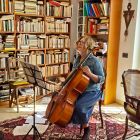Antonello da Messina. A Sicilian in Venice.
Antonello da Messina (c. 1430-1479) is one of the most enigmatic of early Renaissance painters. He came out of nowhere. His life was short, his travels wrapped in mystery. That dear old gossip in Arezzo painter and biographer Giorgio Vasari told impossible tales about him. All useful documents were lost from his hometown, Messina, in Sicily, in the earthquake of 1908. There are no written records of his stays in Venice, but the Venetians knew him well. Today we are aware that his indelible influence on the painters around him and in the lagoon city led to what painting is today.
Antonello is best known for the ravishing vividness of his portraits of fellow Sicilians, rich young men, poor young men, beaten-up Christs, young virgins about to lose their virginity, Madonnas. And also for the deliciously detailed interiors and exteriors, whimsical vistas stretching to the far seascapes of the Straits of Messina or the Venetian lagoon, under limpid swallow-streaked skies.
According to his biography in Vasaris The Lives of the Artists, Antonello is supposed to have journeyed all the way to Flanders and to have extricated the secret of oil painting from its inventor Jan van Eyck until then painters used drier and less manageable egg tempera. He was also supposed to have met Piero della Francesca, one of the first to experiment with a new compositional device perspective in person.
However, after the fall of Constantinople there was a criss-cross of trade routes in the Mediterranean influenced by French, Spanish and Flemish politics and culture. Influences in art were wafted into the studios like trade winds and cross-pollinated everywhere. Antonello used the wooden panels of the Italians: poplar, peach, linden and nut wood exclusively never oak wood like the northern Flemish. But he was attracted from afar by the northerners clean outline, their cool love for glass-covered surfaces, their idiosyncratic naturalism which the change from tempera to oil so brilliantly permitted. And indeed he used perspective.
Piercing the picture plane, perspective was a brand-new system in the 15th century, forcing a three-dimensional world onto a two-dimensional one. It made parallel lines appear to converge into one or several vanishing points. It was both an illusion of space expansion and a geometrically balanced abstract arrangement. It was a play of penetration which led to a new awareness.
Antonello came from Sicily, once the Magna Grecia of the most graceful of Greek art, then the wheat basket of Rome and eventually the meeting place of east and west in Palermo. His native harbour city, Messina, was second only to Palermo in its rich trade of wool, silks, linen and ceramics. He was born around 1430, son of a stonemason, a craft close to sculpture. Since there was no discernible school of painting in Messina, he went to lively Naples to study in the workshop of Colantino, a painter of sombre landscapes and saints. Eventually he is known to have made several sojourns in Venice where master painters and influences from all over Europe were meeting. Venice was probably the most happy and fruitful period of his career he died of tuberculosis in Messina when he was only 49 years old.
In this unusually comprehensive exhibition at the Scuderie del Quirinale in Rome there are 34 paintings out of his ascertained life work of 45, brought from museums all over the world. We can admire most of all his scrutiny of human faces in the portraits. They were emotionally involved, not distant and cool like those of the Tuscans and Venetians. Here the mariner of Cefal with his sarcastic smile, there the merchant from Turin with his arrogant mien. Men like these used their power over poor farm boys, who here are the models for the several depictions of Christ.
The Madonna in the blue mantel is a country girl too, with incipient down over her sweet lips. She is subdued, almost sleepy, but humbly accepting her astonishing fate, looking out at the announcing angel, or us, beseeching: Stay! Leave me this last serene moment.
He looked at his fellow Sicilians up close much like the writers Verga, Lampedusa and even Camilleri. The landscapes behind the holy people who are modelled from not so holy Sicilians are breathtakingly detailed. Clear, still fields peopled with bees, hares, birds and riders stretch to the far sea and islands. The landscape of the Antwerp Crucifixion in which the tortured bodies of three slowly dying men arch as in a macabre ballet over a contrastingly serene land is particularly fine.
Two paintings with two landscapes each enclose the show like a parenthesis. At its beginning is the tiny St Jerome from London in his vaulted room with windows right and left on far green fields; and at its end the splendid large St Sebastian from Dresden, an Apollo in ordinary underpants with daintily detailed Venetian cityscapes stretching right and left into a sunlit noon.
Antonello with his short career was different from anyone before or after him, more anecdotal, humorous, both blunt and fine, more emotionally engaged than the sober majestic Tuscans and Venetians around him which here are splendidly exhibited for comparison. Antonello, with a new loose brushstroke freeing himself from the sharp contour, led to Titian and today. He gave us Bellini with his fresh pink girls and men sitting in the heartrending Venetian sunset.
Antonello da Messina. 18 March-25 June.
Scuderie del Quirinale, Via XXIV Maggio 16, tel. 0639967500.
10.00-20.00. Fri and Sat 10.00-22.30.





















